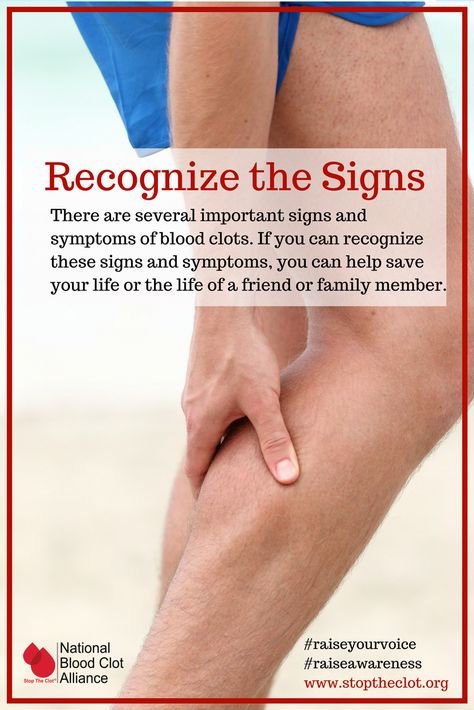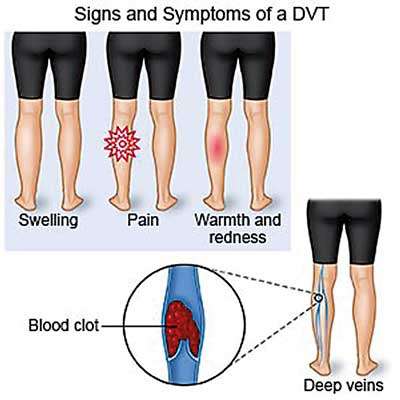Symptoms of a blood clot in calf muscle. Deep Vein Thrombosis (DVT): Symptoms, Causes, and Treatment Options
What are the symptoms of deep vein thrombosis. How is DVT diagnosed. What treatments are available for deep vein thrombosis. Who is at risk for developing DVT. How can deep vein thrombosis be prevented.
Understanding Deep Vein Thrombosis: A Potentially Life-Threatening Condition
Deep vein thrombosis (DVT) is a serious medical condition characterized by the formation of a blood clot in a deep vein, most commonly occurring in the legs. This condition can be potentially life-threatening if left undiagnosed or untreated. DVT often develops after prolonged periods of inactivity, such as during long flights or after surgery, but can also occur due to various other risk factors.
Is DVT a common condition? While exact prevalence rates vary, DVT is considered relatively common, especially among certain high-risk groups. It affects approximately 1-2 per 1,000 people each year in the general population, with higher rates among hospitalized patients and older adults.

Recognizing the Symptoms of Deep Vein Thrombosis
Identifying the symptoms of DVT is crucial for early detection and treatment. However, it’s important to note that some individuals may not experience any noticeable symptoms. When symptoms do occur, they typically manifest in the affected leg and may include:
- Persistent pain or tenderness in the calf muscle
- Swelling in the affected leg
- Warmth in the area of the clot
- Redness or discoloration of the skin
- Pain that worsens when standing or walking
Can DVT symptoms be mistaken for other conditions? Yes, the symptoms of DVT can sometimes be confused with other leg problems, such as muscle strains or cellulitis. This is why proper medical evaluation is essential for an accurate diagnosis.
Risk Factors Contributing to Deep Vein Thrombosis
Understanding the risk factors associated with DVT can help individuals take preventive measures and seek timely medical attention. Some of the primary risk factors include:
- Prolonged immobility (e.g., long-distance travel, bed rest)
- Recent surgery or injury
- Obesity
- Advanced age (over 50 years old)
- Pregnancy and postpartum period
- Use of hormonal contraceptives or hormone replacement therapy
- Personal or family history of blood clotting disorders
- Cancer and cancer treatments
- Smoking
Do all individuals with these risk factors develop DVT? While having one or more risk factors increases the likelihood of developing DVT, it doesn’t guarantee its occurrence. Many people with multiple risk factors never develop the condition, while others with fewer risk factors may experience DVT.

Diagnostic Approaches for Deep Vein Thrombosis
Accurate diagnosis of DVT is crucial for proper treatment and prevention of complications. Healthcare providers typically use a combination of methods to diagnose DVT:
Physical Examination
A thorough physical examination is often the first step in diagnosing DVT. The healthcare provider will look for signs of swelling, tenderness, and discoloration in the affected leg.
D-dimer Blood Test
This blood test measures a substance released when a blood clot breaks down. Elevated levels may indicate the presence of a blood clot, but further testing is usually required for confirmation.
Duplex Ultrasound
This non-invasive imaging test uses sound waves to visualize blood flow in the veins and can detect the presence of a clot.
Venography
In some cases, a contrast dye may be injected into the veins to create detailed X-ray images that can reveal blood clots.
How accurate are these diagnostic methods? While no single test is 100% accurate, the combination of clinical assessment, D-dimer testing, and imaging studies (particularly duplex ultrasound) provides a high level of diagnostic accuracy for DVT.

Treatment Options for Deep Vein Thrombosis
Once DVT is diagnosed, prompt treatment is essential to prevent complications and promote recovery. The main goals of treatment are to stop the clot from growing, prevent it from breaking loose and traveling to the lungs, and reduce the risk of future clots. Common treatment approaches include:
Anticoagulant Medications
Anticoagulants, or blood thinners, are the primary treatment for DVT. These medications don’t actually thin the blood but rather interfere with the clotting process to prevent new clots from forming and existing clots from growing. Common anticoagulants include:
- Heparin (usually given by injection initially)
- Warfarin (oral medication)
- Direct oral anticoagulants (DOACs) such as rivaroxaban, apixaban, and edoxaban
Thrombolytic Therapy
In severe cases or when there’s a high risk of complications, thrombolytic drugs may be administered to dissolve the clot rapidly. This treatment is typically reserved for life-threatening situations due to its associated risks.
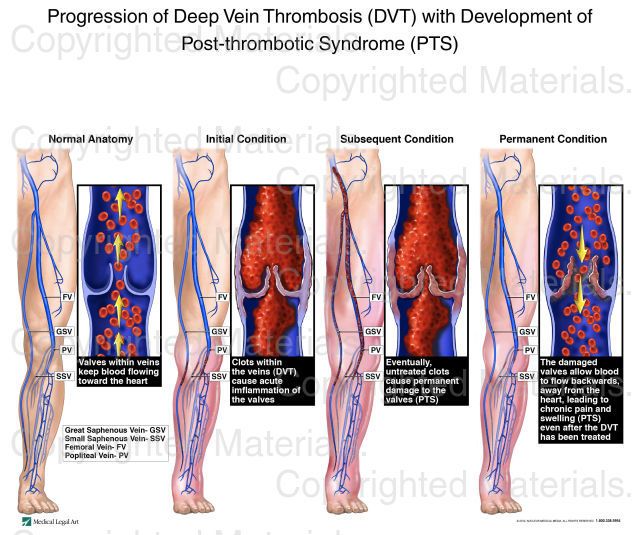
Compression Stockings
These specially designed stockings apply pressure to the legs, helping to reduce swelling and prevent blood from pooling and clotting.
Inferior Vena Cava (IVC) Filters
In cases where anticoagulants are contraindicated or ineffective, an IVC filter may be placed in the large vein that carries blood from the lower body to the heart. This filter can catch clots before they reach the lungs.
How long does DVT treatment typically last? The duration of treatment varies depending on the individual case and underlying risk factors. Anticoagulant therapy often continues for at least 3-6 months, but some patients may require longer-term or even lifelong treatment.
Complications Associated with Deep Vein Thrombosis
While DVT itself is a serious condition, it can lead to potentially life-threatening complications if left untreated. Understanding these complications underscores the importance of early diagnosis and treatment:
Pulmonary Embolism (PE)
The most serious complication of DVT is pulmonary embolism, which occurs when a blood clot breaks free and travels to the lungs, blocking blood flow. PE can be fatal and requires immediate medical attention. Symptoms of PE include:
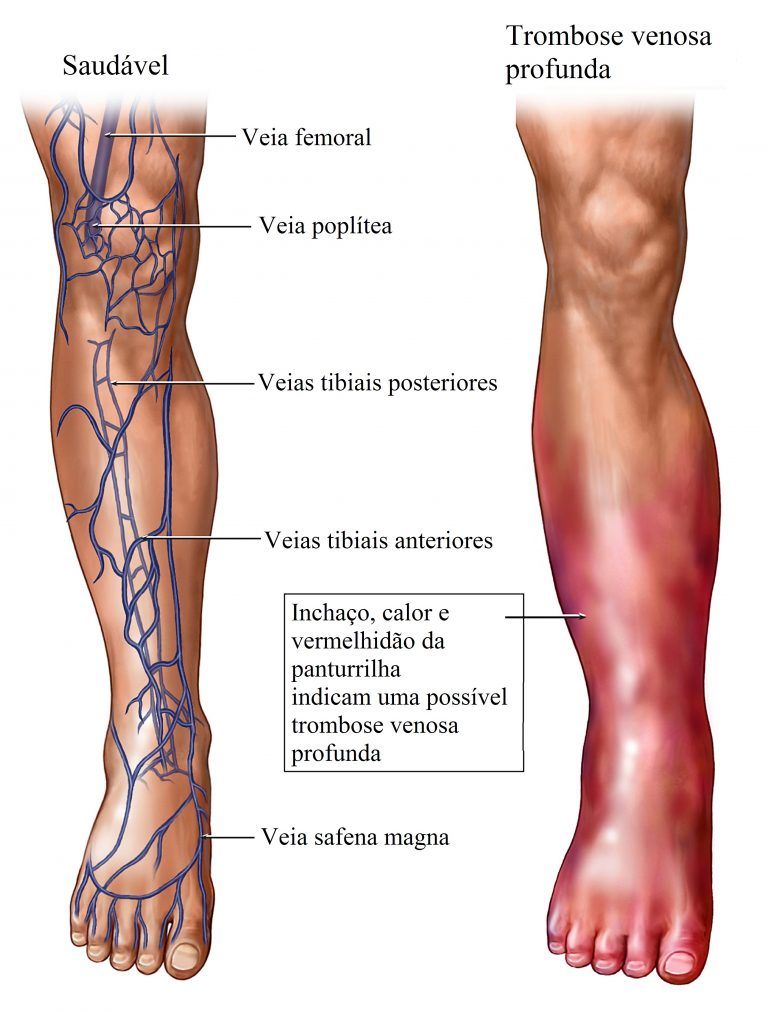
- Sudden shortness of breath
- Chest pain that worsens with deep breathing
- Rapid heartbeat
- Coughing up blood
- Feeling lightheaded or fainting
Post-thrombotic Syndrome (PTS)
This long-term complication can develop months or years after DVT. It occurs when the affected vein is damaged, leading to chronic symptoms such as:
- Persistent swelling in the affected limb
- Pain or discomfort
- Skin discoloration
- Skin ulcers in severe cases
What percentage of DVT patients develop these complications? Studies suggest that approximately 30-50% of patients with DVT may develop post-thrombotic syndrome to some degree. The risk of pulmonary embolism varies, but it’s estimated that about 1 in 10 people with untreated DVT will develop PE.
Preventive Measures for Deep Vein Thrombosis
While not all cases of DVT can be prevented, there are several strategies that can significantly reduce the risk, especially for individuals in high-risk categories:
Stay Active
Regular physical activity, especially exercises that engage the leg muscles, can improve circulation and reduce the risk of blood clots. During long periods of sitting, such as during travel or at work, try to:

- Take frequent breaks to walk around
- Perform simple leg exercises (e.g., ankle rotations, calf raises)
- Avoid crossing your legs for extended periods
Maintain a Healthy Weight
Obesity is a significant risk factor for DVT. Maintaining a healthy weight through proper diet and regular exercise can help reduce this risk.
Stay Hydrated
Adequate hydration helps maintain proper blood viscosity and flow, potentially reducing the risk of clot formation.
Wear Compression Stockings
For individuals at higher risk, such as those recovering from surgery or with a history of DVT, wearing compression stockings can help improve circulation in the legs.
Consider Prophylactic Anticoagulation
In high-risk situations, such as during hospitalization or after certain surgeries, healthcare providers may recommend preventive doses of anticoagulants.
How effective are these preventive measures? While no single measure can completely eliminate the risk of DVT, a combination of these strategies can significantly reduce the likelihood of developing blood clots, especially in high-risk individuals.

Living with Deep Vein Thrombosis: Long-term Management and Care
For individuals who have experienced DVT, long-term management is crucial to prevent recurrence and manage potential complications. This often involves a combination of medical supervision, lifestyle modifications, and ongoing self-care:
Adherence to Medication Regimens
Strictly following prescribed anticoagulant therapy is essential. This may involve regular blood tests to monitor medication levels and effectiveness.
Regular Follow-up Appointments
Maintaining scheduled check-ups with healthcare providers allows for ongoing assessment of treatment efficacy and adjustment of care plans as needed.
Lifestyle Modifications
Incorporating healthy habits into daily life can support overall vascular health and reduce the risk of future clots. This includes:
- Maintaining a balanced diet rich in fruits, vegetables, and whole grains
- Engaging in regular physical activity as approved by healthcare providers
- Quitting smoking and limiting alcohol consumption
- Managing underlying health conditions such as diabetes or hypertension
Ongoing Use of Compression Stockings
Many individuals benefit from continued use of compression stockings to support circulation and manage symptoms of post-thrombotic syndrome.

Awareness of Recurrence Symptoms
Being vigilant about potential signs of new blood clots is crucial. Patients should be educated on recognizing symptoms and seeking prompt medical attention if they occur.
Can individuals fully recover from DVT? While many people recover from DVT without long-term effects, some may experience ongoing symptoms or complications. The likelihood of full recovery depends on various factors, including the size and location of the clot, timeliness of treatment, and individual health status.
Emerging Research and Future Directions in DVT Management
The field of DVT research is dynamic, with ongoing studies aimed at improving prevention, diagnosis, and treatment strategies. Some areas of current research include:
Novel Anticoagulants
Scientists are working on developing new anticoagulant medications that may offer improved efficacy and safety profiles compared to current options.
Personalized Medicine Approaches
Research is exploring how genetic factors and individual patient characteristics can inform more tailored treatment strategies for DVT.

Advanced Imaging Techniques
New and improved imaging methods are being studied to enhance the accuracy and speed of DVT diagnosis.
Minimally Invasive Treatments
Innovative procedures for clot removal or dissolution are under investigation, potentially offering alternatives to traditional anticoagulant therapy in certain cases.
How might these advancements impact DVT care in the future? As research progresses, we may see more precise, personalized, and effective approaches to DVT prevention and treatment, potentially reducing the burden of this condition on individuals and healthcare systems.
Deep vein thrombosis remains a significant health concern, but with increased awareness, improved diagnostic capabilities, and advancing treatment options, the outlook for those affected by this condition continues to improve. By understanding the risk factors, recognizing the symptoms, and adhering to preventive measures and treatment plans, individuals can take proactive steps to protect their vascular health and overall well-being.
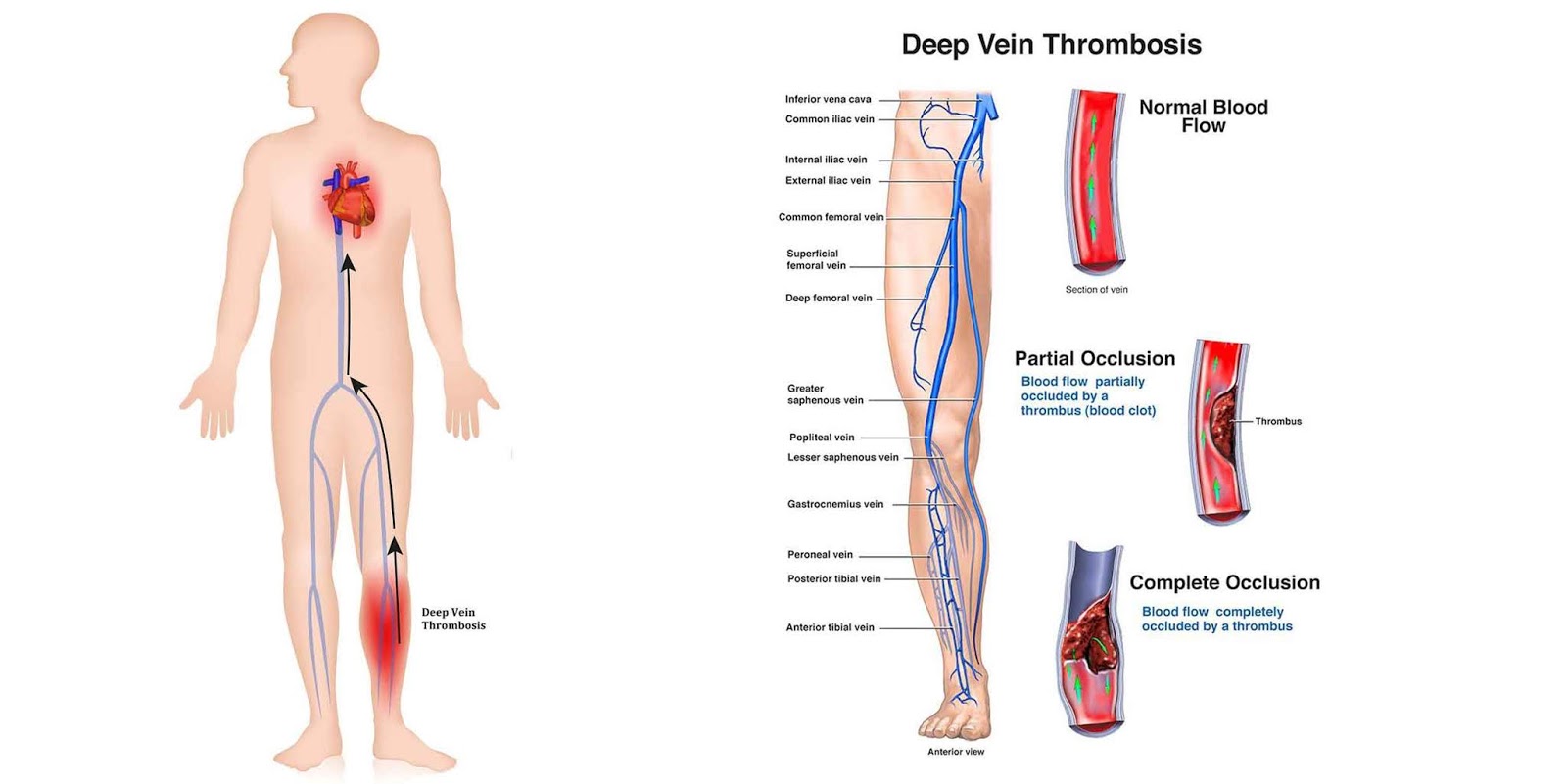
Тромбоз глубоких вен (ТГВ) — симптомы, причины и лечение
3 октября 2022 г.
Тромбоз глубоких вен или ТГВ представляет собой тромб в вене. Это чаще всего встречается в области икроножных мышц, особенно после операций и длительных перелетов. Не путайте это с растяжением голени. Неправильное лечение может вызвать опасные для жизни осложнения.
Объявление
Симптомы тромбоза глубоких вен
Симптомы тромбоза глубоких вен состоят из:
- Постоянная боль, обычно в икроножной мышце в задней части голени.
- Нежность глубоко внутри мышц.
- Возможно, у вас опухоль в области икроножной мышцы.
- Температура кожи может казаться горячей на ощупь.
- Иногда на коже видны красные пятна.
Боль может воспроизводиться при пассивном растяжении икроножной мышцы (вы расслабляете мышцу, пока кто-то другой двигает ногой для ее растяжения).
Диагностика
тромбоз вен 2 . Это контрольный список факторов риска, которые, как считается, увеличивают риск. Если у пациента более одного из девяти возможных, то, вероятно, ТГВ.
Это контрольный список факторов риска, которые, как считается, увеличивают риск. Если у пациента более одного из девяти возможных, то, вероятно, ТГВ.
Что такое тромбоз глубоких вен?
Тромбоз глубоких вен (ТГВ) представляет собой тромб в вене. Это чаще всего встречается в области икроножных мышц, особенно после операции или у тех, кто совершал дальние перелеты. Это связано с тем, что пациент сидит неподвижно в течение длительного времени в сочетании с изменением атмосферного давления. Он также может развиваться как осложнение артроскопической хирургии 1 .
ТГВ встречается относительно часто, особенно у следующих лиц:
- Люди с избыточным весом
- Люди старше 50 лет
- Люди с нарушением кровообращения.
Это не то, что вы ожидаете от молодых спортсменов. Однако это состояние потенциально смертельно, если его не распознать. Это связано с тем, что если тромб отрывается, он может попасть по кровеносной системе в сердце, легкие или мозг. В результате потенциально вызывает сердечный приступ, легочную эмболию или инсульт.
В результате потенциально вызывает сердечный приступ, легочную эмболию или инсульт.
Если массажист пропустит это или ошибочно диагностирует ТГВ как растяжение икроножных мышц и применит глубокий массаж тканей к этой области, это может привести к освобождению тромба и причинить серьезный вред или что-то похуже.
Лечение
Если вы подозреваете ТГВ, немедленно обратитесь за медицинской помощью. Обратитесь к врачу, который может дать профессиональное заключение и направить вас на дальнейшее обследование. Сканирование подтвердит диагноз.
Лечение обычно включает ежедневные инъекции антикоагулянта, известного как гепарин, в течение недели.
Затем следует второй антикоагулянтный препарат под названием варфарин, принимаемый в форме таблеток ежедневно в течение 6 месяцев.
Ваш врач будет делать регулярные анализы крови, чтобы убедиться, что доза лекарства правильная. Слишком много варфарина увеличивает риск кровотечения, а слишком мало увеличивает риск роста сгустка.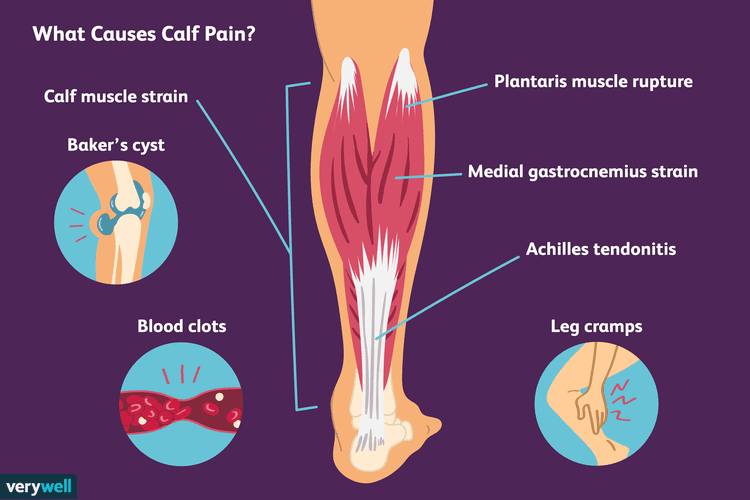
Важно! – Варфарин не следует применять у беременных, так как он может вызвать врожденные дефекты.
Каталожные номера
- Jaureguito JW, Greenwald AE, Wilcox JF et al. Частота тромбоза глубоких вен после артроскопической операции на коленном суставе. Am J Sports Med 1999;27(6):707–10.
- Уэллс П.С., Хирш Дж., Андерсон Д.Р. и др. Точность клинической оценки тромбоза глубоких вен. Ланцет, 1995;345(8961):1326-30.
Тромбоз глубоких вен (ТГВ) | Узнайте о признаках и методах лечения ТГВ
Тромбоз глубоких вен (ТГВ) — это сгусток крови, который образуется в глубокой вене, часто в ноге. Как правило, люди с ТГВ не имеют ни малейшего представления об этом, потому что симптомы, связанные с ним, практически отсутствуют. Есть некоторые люди, которые подвержены более высокому риску развития ТГВ, чем другие, поэтому важно, чтобы вы понимали симптомы и риски, связанные с этим типом смертельного тромба.
Кто подвержен риску ТГВ?
Существуют определенные состояния, которые могут увеличить риск развития ТГВ, в том числе:
- Нарушение свертываемости крови — Если у вас нарушение свертываемости крови, вы можете подвергаться более высокому риску ТГВ, чем другие.
- Продолжительный постельный режим, сидение и т. д. — Когда ваши ноги остаются неподвижными в течение длительного периода времени, икроножные мышцы не могут сокращаться, что означает, что кровь не циркулирует должным образом, что увеличивает риск образования тромбов.
- Беременность – Женщины во время беременности испытывают повышенное давление на вены, особенно в области ног и таза. Если вы беременны с наследственными нарушениями свертываемости крови, вы можете подвергаться еще большему риску.
- Недавняя травма или операция — Любая травма ног или вен, а также операция могут увеличить риск образования тромбов.

- Противозачаточные средства — Гормоны в оральных контрацептивах могут ускорить свертываемость крови и увеличить вероятность образования тромба в ноге.
- Избыточный вес — Когда у вас избыточный вес или ожирение, вы увеличиваете давление на вены и повышаете вероятность образования тромбов.
- Рак – Некоторые виды рака могут повышать уровень факторов свертывания крови.
- Курение – Курение влияет на способность вашего организма эффективно циркулировать кровь, что увеличивает риск ТГВ.
- Возраст – Если вам больше 60 лет, ваш риск автоматически увеличивается, но вы должны знать, что ТГВ может возникнуть в любом возрасте.
Авиаперелеты также способствуют повышенному риску ТГВ .
Каковы симптомы ТГВ?
Симптомы проявляются не у всех; на самом деле, некоторые люди никогда не испытывают никаких симптомов.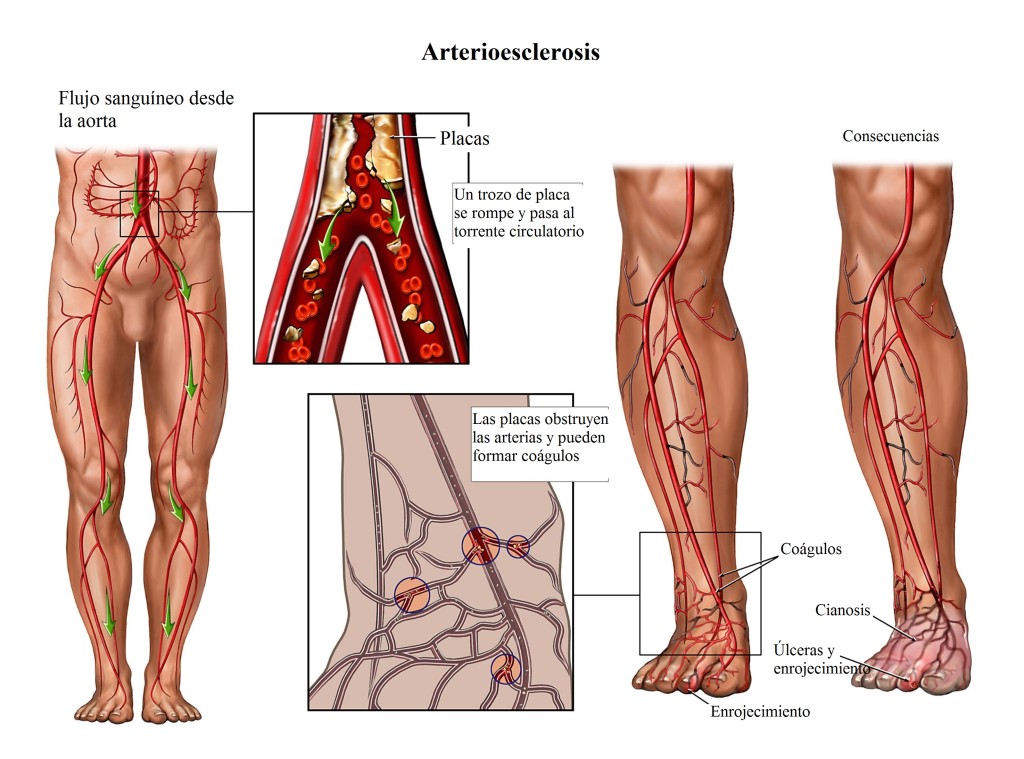 Однако те, кто это делает, могут жаловаться на отек в пораженной ноге или боль, исходящую из этой ноги, которая начинается в голени и ощущается как болезненность или сильные судороги.
Однако те, кто это делает, могут жаловаться на отек в пораженной ноге или боль, исходящую из этой ноги, которая начинается в голени и ощущается как болезненность или сильные судороги.
Каковы риски ТГВ?
Если тромбоз глубоких вен не лечить, возникает серьезное осложнение в виде легочной эмболии, которая может привести к летальному исходу. Легочная эмболия (ТЭЛА) возникает, когда кровеносные сосуды легких блокируются тромбом, который попал из другой части тела (например, из ноги).
Лица, подверженные риску развития ТГВ, должны обращать внимание не только на его признаки и симптомы, но и на симптомы ТЭЛА, которые включают:
- Необъяснимая одышка
- Боль в груди, усиливающаяся при глубоком вдохе или кашле
- Чувство головокружения или обморок
- Кровавый кашель
- Учащенное сердцебиение
The Vascular Experts – одна из крупнейших групп сертифицированных сосудистых хирургов в стране.